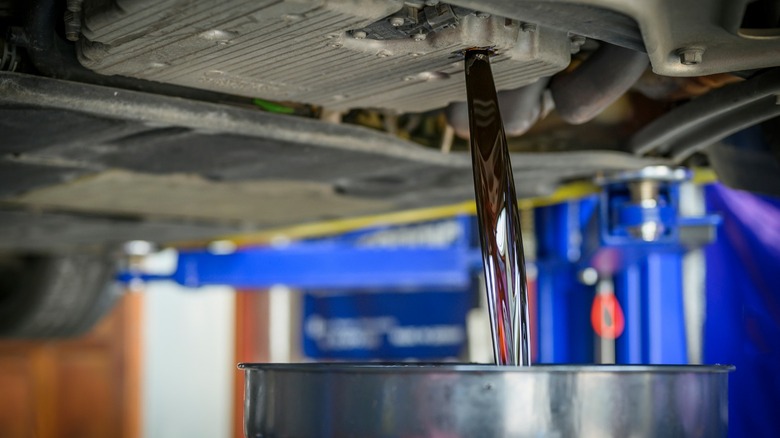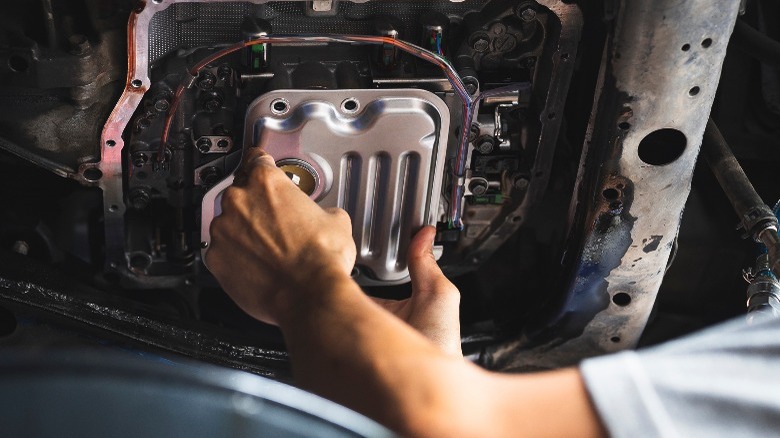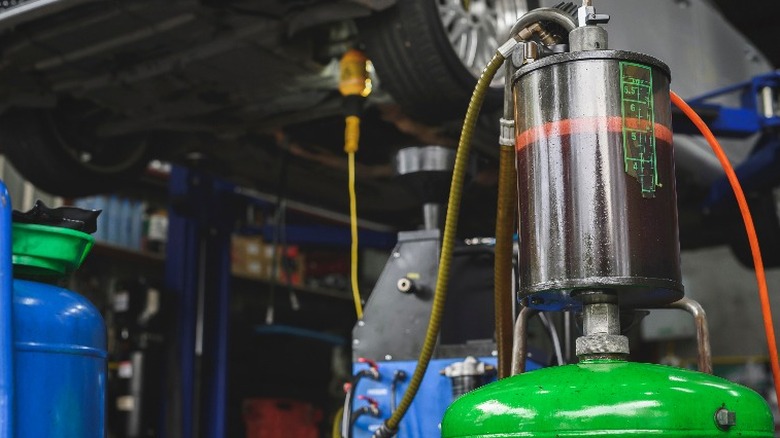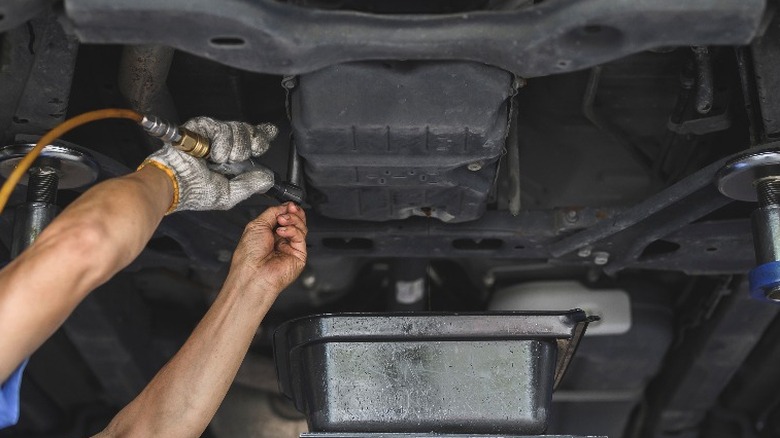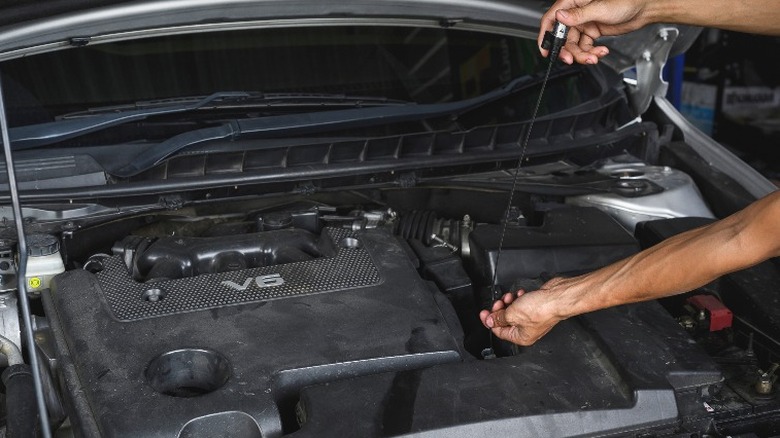How To Perform A Transmission Flush On Your Vehicle
Your car's transmission is a vital part of its anatomy. It's responsible for taking the raw power created by the engine and scaling it down to various driving situations. The transmission is what makes it possible to drive at different speeds, take off from a stop, and decelerate when it's time to slow down. But the transmission isn't just a magic box that does all of that on its own. Transmissions work using a particular type of hydraulic fluid. This pressurized fluid helps actuate valves inside the transmission, move gears, and lubricate all moving parts. While transmission fluid is durable and long-lasting, it's subject to degradation over time and will eventually lose its ability to help your transmission function properly.
Because transmission fluid breaks down over time, it must be replaced periodically. Most manufacturers provide specific schedules for transmission fluid flushes and replacements. A transmission flush is a relatively simple procedure, but the steps can vary depending on your car's make and model. There's also a distinction between a transmission flush and a transmission fluid change.
Generally, a flush involves draining the transmission fluid, connecting a machine or other apparatus to the transmission cooler lines to purge any remaining old fluid, and then refilling the system with fresh fluid. However, some vehicles require additional steps, like replacing the transmission fluid filter and installing a new pan gasket. A transmission fluid change, on the other hand, is a simple drain and fill procedure. Typically, a drain and fill is all you'll need to do, as flushes are more time-consuming and require more equipment. That said, there are ways to perform a flush at home if you're a confident DIYer. Let's dive in and take a deeper look at transmission flushes and how to perform them.
How to flush an automatic transmission
Flushing your transmission is a fairly straightforward task. However, the procedure can differ slightly from car to car and depending on your transmission type. For automatic transmissions, including continuously variable transmissions (CVTs), the steps are relatively similar.
-
Lift the vehicle off the ground.
-
Remove the transmission fluid drain plug or remove the pan and allow the old fluid to drain (you'll have to remove the pan no matter what if you plan to replace the filter).
-
Remove the old filter and replace it while the pan is off.
-
Clean the old gasket material and the drain pan mating surface before installing a new gasket.
-
Torque the pan bolts to their proper specification.
-
Replace the drain plug if applicable.
-
Lower the car and remove the transmission fluid dipstick.
-
Measure the amount of fluid that you drained from the transmission, and add that same amount of clean fluid to the transmission via the dipstick tube.
-
Locate your car's transmission cooler lines.
-
Attach one end of a hose to the outlet or return line and place the other end in a bucket or drain pan.
Advertisement -
Start the engine.
-
Allow the new fluid to drain into your bucket (this is the flushing procedure that will clear out any grime and gunk from the transmission).
-
Continue adding more fluid to the transmission until the liquid leaving the return hose looks bright red and clean.
-
Turn off the engine and reconnect the return line.
-
Start the engine and check your transmission fluid level using the dipstick.
-
Add more fluid until the level is within the appropriate range.
-
Test drive your car.
How to flush a sealed transmission
A sealed transmission does not have a dipstick, meaning you can't check the fluid level or fill the transmission with new fluid from the engine bay. Instead, these transmissions typically have a drain hole and a fill hole located directly on the transmission. Flushing a sealed transmission is significantly more complex than flushing an unsealed one. You'll need a pump, which you can find at most auto parts stores, a piece of hose, and a clear container.
-
Check your vehicle repair manual to determine your car's overall transmission fluid capacity.
-
Remove the transmission drain plug and allow the fluid to drain into a clear container.
-
When the fluid stops draining, replace the drain plug.
-
Measure the amount of fluid that drained out of the pan.
-
Locate the fill plug and use your pump to add the same amount of fresh fluid that you previously drained.
-
Locate the transmission cooler hoses and disconnect the return line.
-
Attach a piece of hose to the return line and place the other end in your clear container.
-
Start the engine and drain one quart into the container.
-
Stop the engine and use your pump to add one quart to the transmission.
-
Repeat this procedure until you've drained and added the maximum fluid capacity for your car (at that point, the fluid leaving the return hose should be red and clean).
Advertisement -
Replace the fill plug.
-
Take your vehicle for a test drive.
How to flush a manual transmission
Manual transmissions differ from automatic transmissions in that they're much simpler and easier to maintain. These transmissions do not have filters or cooler lines, meaning you can't flush them in the same sense that you can flush an automatic transmission. Instead, when it comes to servicing a manual transmission, you'll basically just be performing a drain and fill. Manual transmissions can be sealed or unsealed, meaning you may need a pump to complete the procedure. You can determine whether your car has a sealed transmission by checking the engine bay for a transmission fluid dipstick. Follow the procedure below to replace the fluid in your manual transmission.
-
Lift the car off the ground.
-
Remove the transmission drain plug or the pan and allow the fluid to drain.
-
Replace the plug or pan (if you removed the pan, you'll need to replace the gasket and retorque the bolts to their proper specification).
-
If your transmission is sealed, measure the fluid that you drained and pump the same amount of clean fluid in through the fill hole.
-
If your transmission is unsealed, lower the car and fill the transmission with the appropriate amount of fluid.
-
Start the engine and let it run while you continue to check the fluid level.
-
Add more fluid if necessary.
-
Take your car for a test drive.
When do you need to perform a transmission flush?
Your car's manufacturer provides a maintenance schedule for routine services, including transmission fluid flushes. The intervals will depend on various factors, including your vehicle's make and model, the type of transmission it uses, and the type of fluid. You can find this information in your owner's manual, your repair manual, or by contacting your local dealership. However, most cars need a transmission fluid service every 30,000 to 100,000 miles.
Outside of regular transmission service, you may need to replace your fluid if you experience any symptoms of transmission damage. Some of the most common signs that your transmission fluid is bad include an overheating transmission, dashboard warning lights, jerky or irregular shifting, and stalling issues. Over time, transmission fluid can accumulate debris and metal shavings. It's vital that you replace the fluid regularly to avoid damage and keep your transmission shifting smoothly. The best way to protect your transmission is to follow your manufacturer's instructions and keep up with a routine maintenance schedule.
